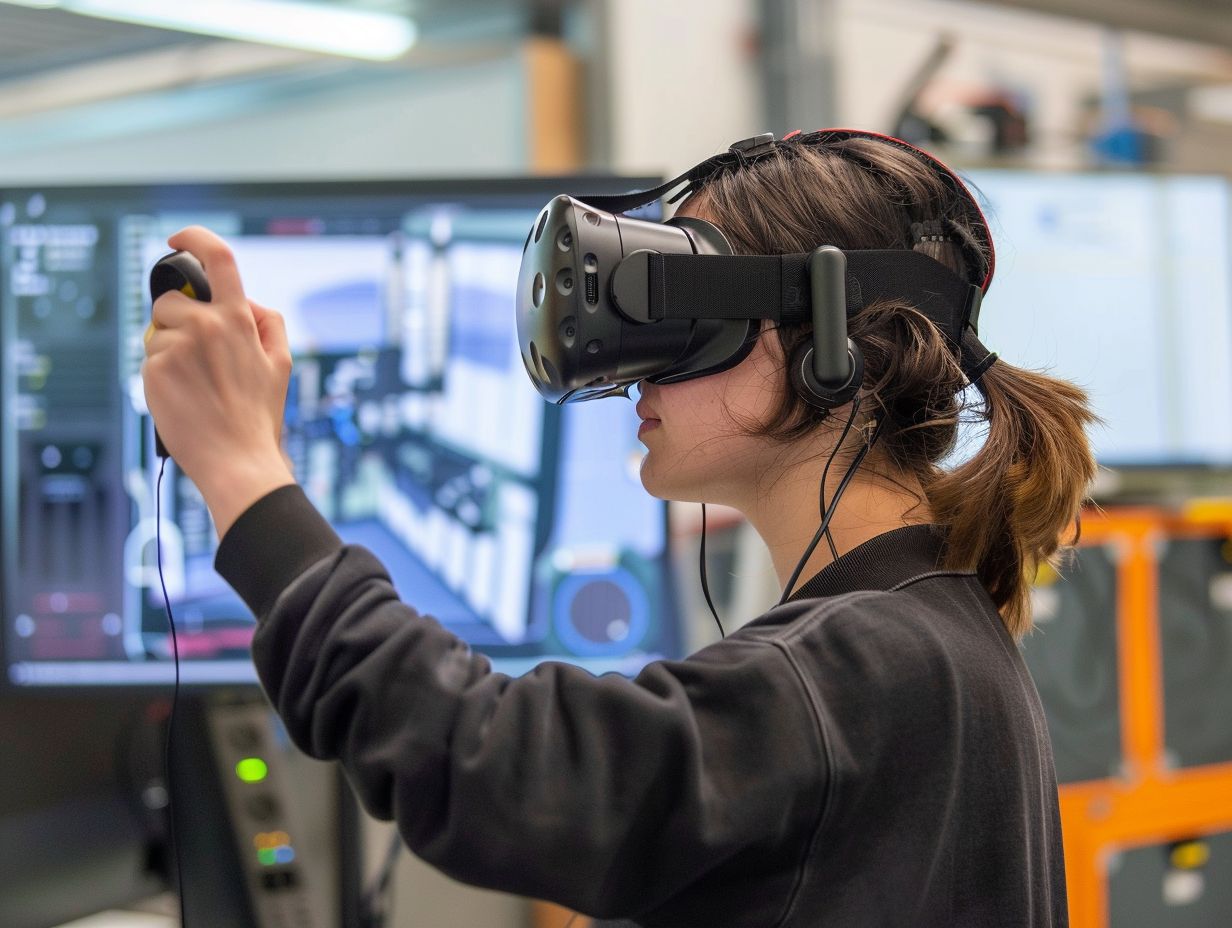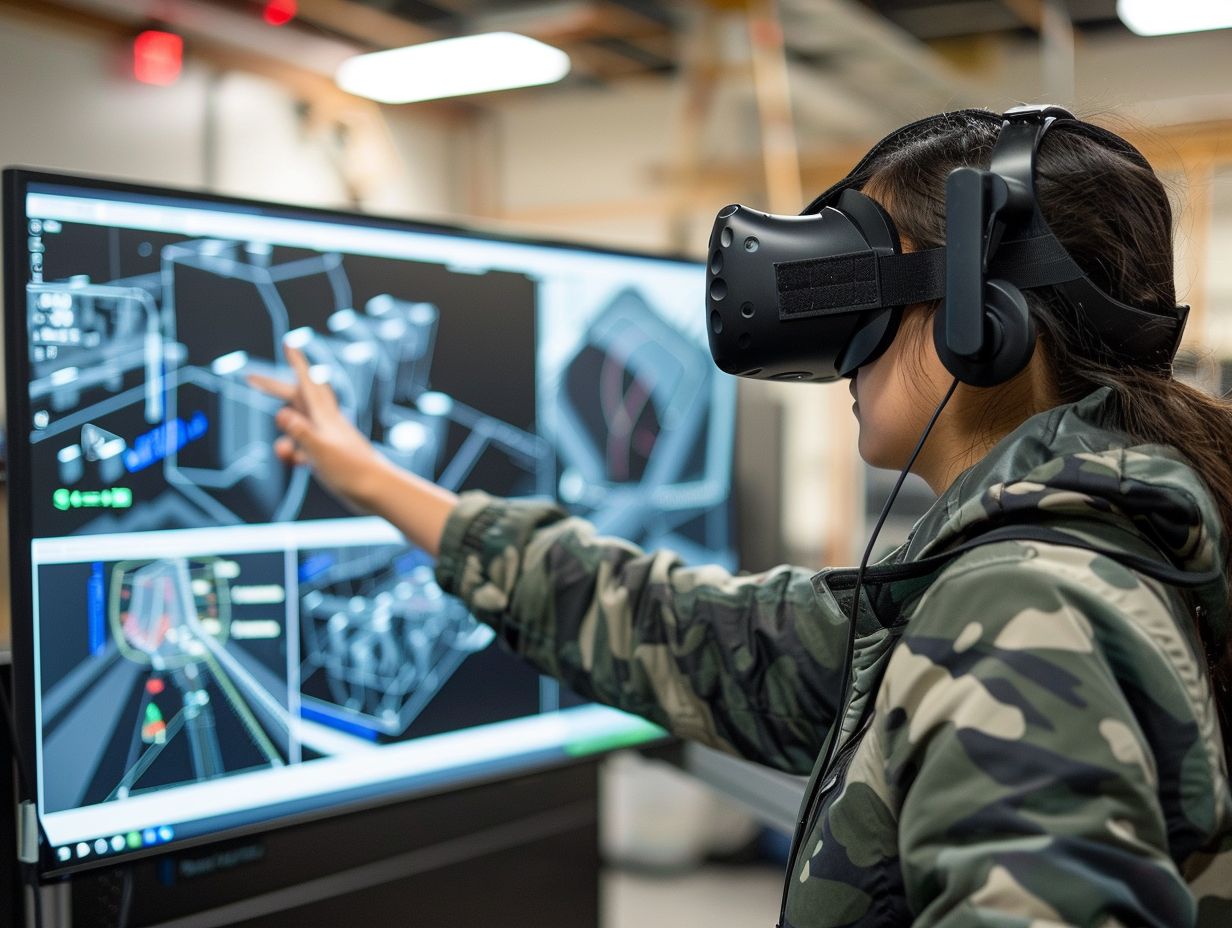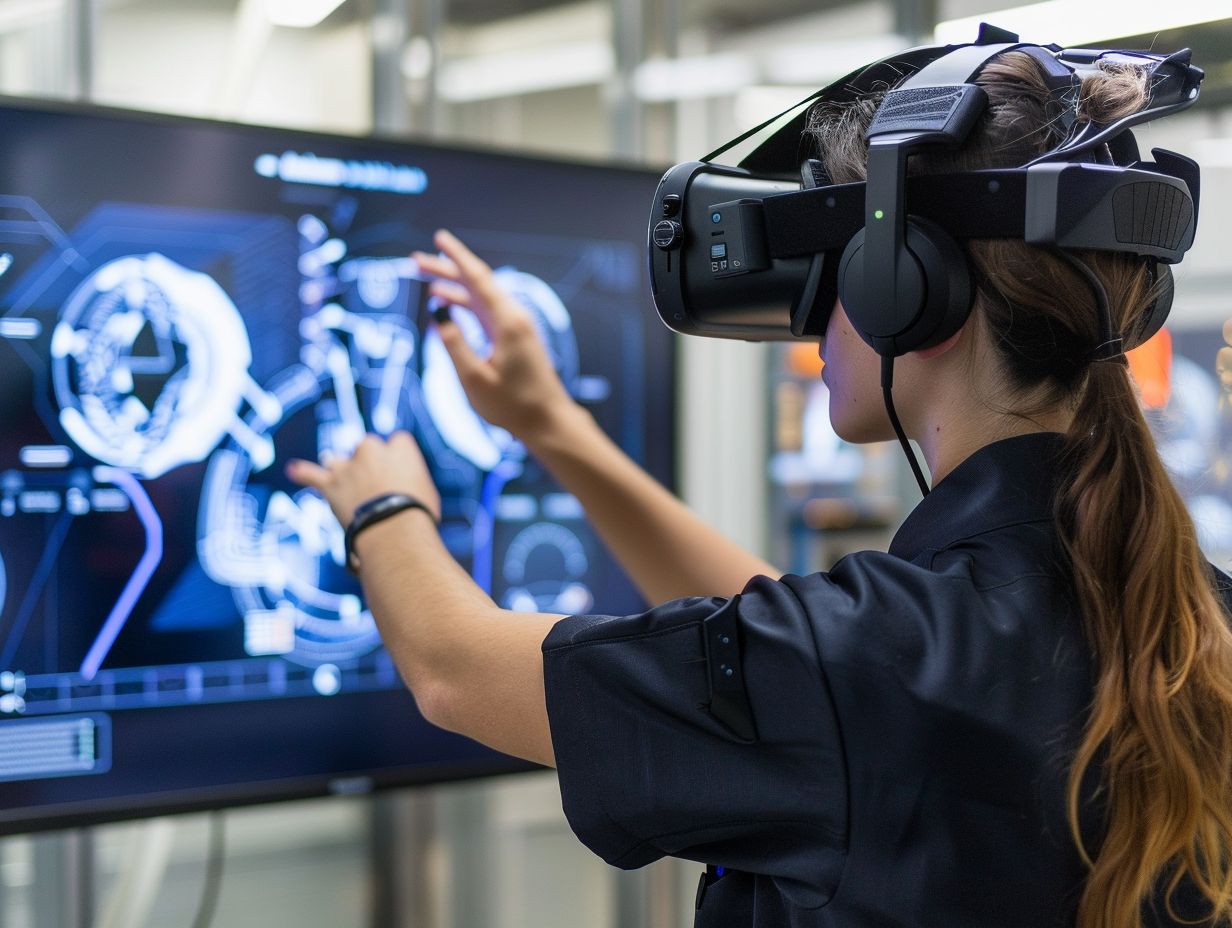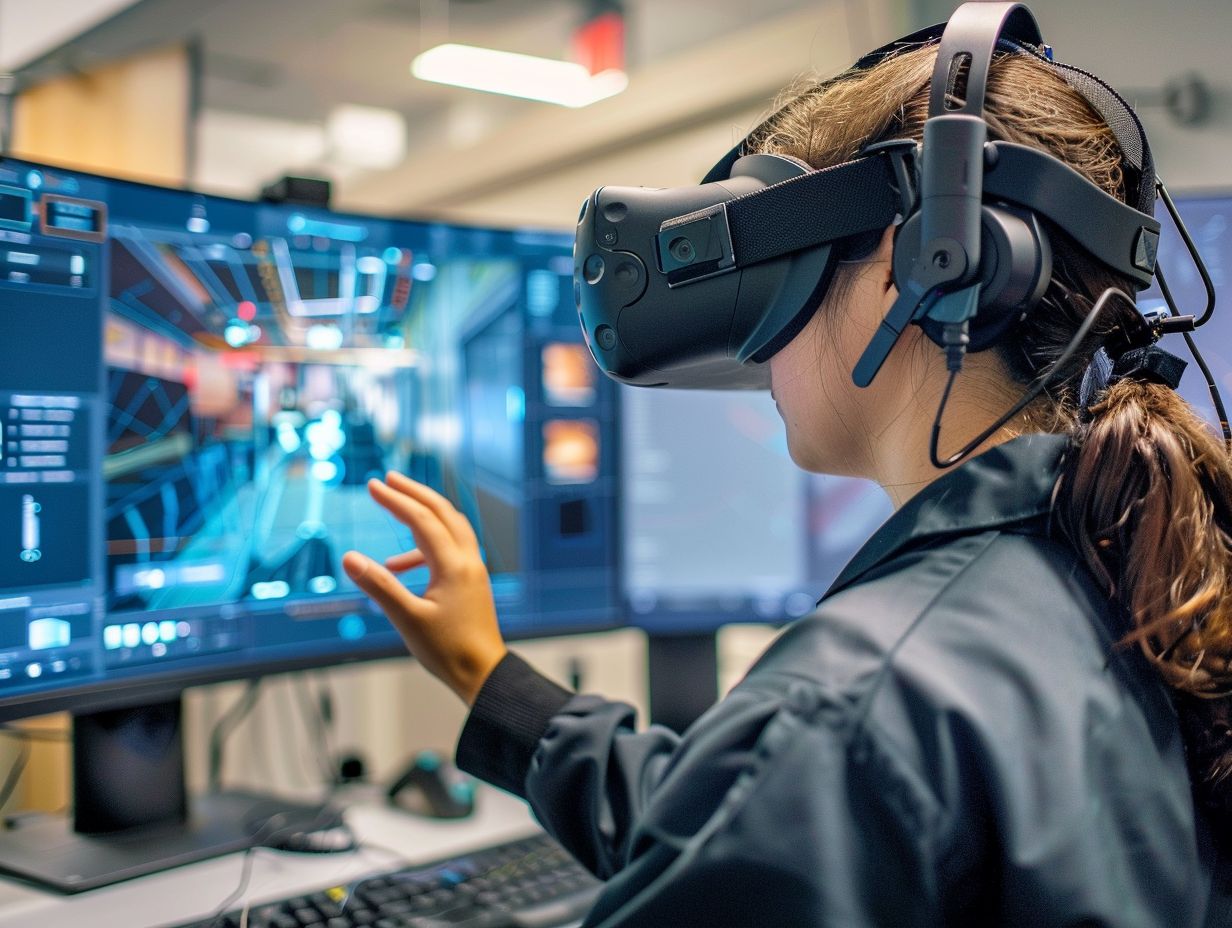Virtual Reality (VR) technology has revolutionized the field of technical training, offering you an immersive and interactive learning experience like never before.
Throughout this article, you will explore the definition and key concepts of VR, along with the benefits it brings to technical training, such as improved learning outcomes and cost savings.
Delve into the different types of VR training programs, considerations for implementation, as well as the challenges and limitations faced in this emerging field.
Join us on this journey as we uncover the rise of VR in technical training and discuss the potential developments and applications that the future holds for VR in technical training.
Key Takeaways:

Understanding Virtual Reality (VR)
Virtual Reality (VR) is a technology that creates a simulated environment providing you with an immersive learning experience. It is widely used in education and training to enhance your learning through interactive VR applications.
This technology allows you to engage with content in a dynamic and interactive way, making complex subjects more understandable and memorable. In education, VR simulations can transport you to historical events, scientific experiments, or even outer space, allowing you to experience learning in a completely new dimension. Through hands-on virtual experiences, you can practice real-life scenarios in a safe and controlled environment, such as medical simulations for aspiring doctors or virtual field trips for geography classes. The interactive nature of VR encourages active participation, boosts engagement, and helps in retaining information more effectively.
Definition and Key Concepts
Virtual Reality (VR) technology is leading the way in transforming traditional training methods into immersive experiences for employee development. It aims to achieve specific training objectives through simulated environments accessed via VR headsets.
By incorporating VR headsets, organizations can create highly realistic and interactive training scenarios that engage employees in hands-on learning experiences. This technology allows individuals to practice skills and procedures in a safe virtual setting before executing them in real-world situations.
VR enables you to learn at your own pace, boosting retention rates and overall performance. The ability to simulate various work environments and challenges enhances knowledge retention and ensures that you are well-equipped to handle your role effectively.
Benefits of VR in Technical Training
When you integrate Virtual Reality (VR) into technical training programs, you can reap numerous advantages, such as improved learning outcomes, time and cost savings, and the ability to simulate diverse training scenarios using VR devices.
Through the incorporation of VR technology, learners immerse themselves in interactive and lifelike environments that facilitate a more effective grasp of complex concepts. The hands-on experience offered by VR training hardware leads to enhanced retention of knowledge and skills.
The cost-effectiveness of VR training programs in comparison to traditional methods represents a notable benefit, as it diminishes expenses associated with travel, physical resources, and instructor fees. With VR, instructors can design a variety of scenarios, ranging from troubleshooting equipment malfunctions to rehearsing emergency response procedures, thereby augmenting the adaptability and versatility of training initiatives.
Improved Learning Outcomes
One of the key benefits of incorporating Virtual Reality (VR) technology in training is the significant improvement in learning outcomes. VR applications allow learners to acquire and practice skills in immersive learning environments, enhancing their understanding and retention of VR content.
By simulating real-world scenarios and providing interactive experiences, VR content facilitates hands-on skill development. You can engage in virtual simulations that require critical thinking and problem-solving, helping you translate theoretical knowledge into practical applications effectively. The interactive nature of VR technology fosters active participation and engagement, promoting a deeper level of learning.
Through these experiences, you can refine your skills, build muscle memory, and increase proficiency in various tasks. As a result, the incorporation of VR content in training programs holds immense potential for enhancing skill acquisition and overall learning outcomes.
Cost and Time Savings
 An additional benefit of VR in technical training is the cost and time efficiency it provides. By utilizing VR software for task analysis and developing effective training programs, organizations can offer impactful VR training experiences across multiple training sectors.
An additional benefit of VR in technical training is the cost and time efficiency it provides. By utilizing VR software for task analysis and developing effective training programs, organizations can offer impactful VR training experiences across multiple training sectors.
Through the integration of VR technology, businesses can streamline their training procedures by creating simulations of real-world situations within a secure and controlled setting. This not only enhances the learning process but also enables trainees to practice and refine skills without the potential for costly mistakes.
VR training courses can be tailored to meet the specific requirements of various industries such as healthcare, aviation, automotive, and more, providing specialized learning opportunities that align with each industry’s distinct needs. This customized approach ensures that training is not only highly relevant but also significantly effective for the learners.
Types of VR Training Programs
Various types of Virtual Reality (VR) training programs leverage interactive training environments within a virtual setting. These programs evolve with advancements in VR technology, enabling dynamic scenario generation for diverse VR training applications.
VR training programs are designed to provide a range of realistic scenarios that immerse users in lifelike experiences. The advancements in VR technology allow for the creation of detailed virtual environments that replicate real-world situations. From medical simulations to corporate training exercises, VR training applications span across industries, offering a hands-on approach to learning and skill development. With scenario generation capabilities, you can actively engage with different challenges and decision-making processes, enhancing your problem-solving skills in a safe and controlled virtual setting.
Simulations and Interactive Modules
Simulations and interactive modules play a crucial role in VR training programs, allowing your organization to define specific training targets and streamline the training process. These VR simulations contribute significantly to the overall effectiveness of VR training experiences by providing hands-on learning opportunities.
By incorporating simulations, your VR training programs can accurately replicate real-life scenarios, enabling users like yourself to practice and apply skills in a risk-free environment. The interactive nature of these modules engages learners actively, boosting retention and knowledge transfer. Feedback mechanisms in VR simulations help assess performance, allowing for targeted improvements and personalized learning paths.
The use of such immersive technologies enhances the efficiency of training programs, enabling you to achieve set training targets effectively while ensuring a more engaging and interactive learning experience.
Implementing VR in Technical Training
When implementing Virtual Reality (VR) in technical training, you need to consider various factors. These include creating engaging VR content, selecting suitable VR devices like Head-Mounted Displays (HMDs), overcoming challenges such as motion sickness, and integrating tracking devices for user interaction.
To develop compelling VR content for technical training, you must prioritize immersive experiences that facilitate hands-on learning. This can involve interactive simulations, virtual workshops, and scenario-based exercises that improve engagement and information retention.
Furthermore, the selection of appropriate VR devices is critical. Opt for HMDs with high-resolution displays and comfortable wearability to ensure an effective training experience. Additionally, address concerns related to motion sickness through proper design methods, and incorporate tracking devices to enable precise user interaction, thereby enhancing the overall effectiveness of the training program.
Considerations and Best Practices
When implementing VR in technical training, you should consider best practices such as incorporating advanced technologies like Leap Motion and Kinect sensors for precise body tracking, providing haptic feedback for realistic interactions, and optimizing locomotion experiences for seamless user engagement.
These advanced technologies play a crucial role in enhancing the overall training experience. Leap Motion and Kinect sensors enable the system to accurately track the user’s movements, allowing for more effective simulation and assessment. The integration of haptic feedback technology provides users with tactile sensations, further immersing them in the virtual environment. Optimized locomotion experiences help prevent motion sickness and ensure that users can navigate the virtual space comfortably, enhancing both learning outcomes and user satisfaction.
Challenges and Limitations of VR Training

Despite its benefits, Virtual Reality (VR) training faces challenges and limitations related to the availability of quality VR headsets, achieving immersive levels of interaction, adapting VR applications to different training contexts, creating spatial presence, and measuring training outcomes effectively.
Ensuring a high level of immersion in VR training sessions is critical for creating engaging and effective learning experiences. The quality of VR headsets plays a pivotal role in determining the extent of immersion that can be achieved.
The process of adapting VR applications to various training contexts can be complex and time-consuming, requiring careful consideration of factors such as user interaction and scenario design. Establishing spatial presence within virtual environments is another hurdle, as it involves creating a sense of physical presence and interaction in a digital space.
Evaluating training outcomes in VR environments requires specialized methods and tools to accurately assess the effectiveness and impact of the training programs.
Addressing Technical Issues and Human Factors
Addressing technical issues and human factors is crucial when optimizing Virtual Reality (VR) training experiences. You need to ensure the compatibility of VR devices, enhance spatial presence through advanced HMDs, leverage the latest VR technology advancements, and refine VR simulations to achieve effective learning outcomes.
By tackling technical challenges like reducing latency and improving resolution in VR devices, learners can fully immerse themselves in the virtual environment. Human factors, such as designing intuitive user interfaces and integrating interactive elements, are pivotal in engaging trainees. The implementation of realistic and impactful VR simulations can replicate real-world scenarios, improving both skill acquisition and retention.
Taking a comprehensive approach that considers both technical and human-centered aspects is essential for creating engaging and successful VR training experiences.
The Future of VR in Technical Training
The future of Virtual Reality (VR) in technical training holds promise for innovative training tasks, dynamic scenario generation, ongoing VR training research, and continuous advancements in VR technology to revolutionize the learning and development landscape.
VR technology has the potential to immerse learners in diverse and challenging environments, offering realistic simulations for hands-on experience in fields like medical procedures, engineering simulations, and emergency response scenarios. The adaptability of VR training tasks allows for customization based on individual learning needs, offering a flexible and engaging learning experience.
Ongoing research in VR training focuses on enhancing user experience, optimizing performance metrics, and exploring new applications in various industries. As VR technology continues to evolve, it presents exciting opportunities for organizations to improve training efficiency and effectiveness.
Potential Developments and Applications
The future of Virtual Reality (VR) in technical training is poised to bring about exciting advancements in various training applications, immersive training experiences, customizable training scenarios, and the progression of sophisticated VR training hardware aimed at enhancing the learning process.
With the incorporation of VR into technical training, industries have the capacity to craft lifelike and interactive training scenarios that offer a heightened level of engagement. Leveraging AR and VR technology permits learners to fully immerse themselves in simulated environments, facilitating the practice of real-world tasks and the receipt of immediate feedback. This personalized and hands-on approach not only enhances knowledge retention but also accelerates the learning curve.
The development of VR training hardware, including advanced headsets and controllers, facilitates a more seamless and intuitive training experience for users, pushing the boundaries of conventional training methodologies.
Frequently Asked Questions
What is virtual reality and how is it being used in technical training?

Virtual reality, or VR, is a computer-generated simulation of a three-dimensional environment that can be interacted with in a seemingly real or physical way. In technical training, VR is being used as a tool to create immersive and realistic training experiences for individuals to practice and learn new skills.
How does virtual reality benefit technical training?
Virtual reality offers numerous benefits in technical training, such as providing a safe and controlled environment for learners to practice without any real-world consequences. It also allows for hands-on learning and the ability to repeat exercises as many times as needed for mastery.
What industries are utilizing virtual reality in technical training?
Many industries are incorporating virtual reality into their technical training programs, including healthcare, manufacturing, aviation, and military. It is also being used in fields such as engineering, construction, and automotive.
What types of skills can be taught through virtual reality in technical training?
Virtual reality can be used to teach a wide range of technical skills, from basic procedures and safety protocols to complex tasks and troubleshooting techniques. It can also be utilized for soft skills training, such as communication and teamwork.
Can virtual reality replace traditional training methods?
While virtual reality can enhance and supplement traditional training methods, it cannot completely replace them. It is best utilized as a supplement to provide hands-on practice and to reinforce concepts learned in traditional training.
Are there any drawbacks to using virtual reality in technical training?
One potential drawback to using virtual reality in technical training is the cost of equipment and development. It also requires a significant amount of time and resources to create effective VR training programs. Additionally, not all learners may have access to the necessary equipment, making it difficult to implement on a large scale.
